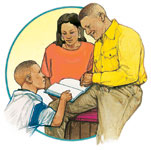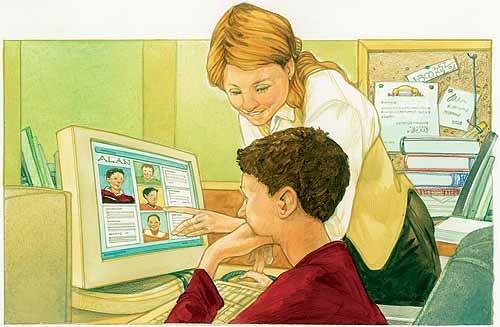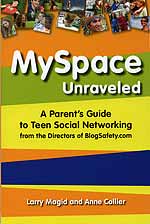
Helping Children Stay Smart and Safe on Social Networks
By Cynthia Wallace
Illustration by Joel Snyder
It's getting more difficult for parents to know a child's friends, because many new relationships begin and develop in cyberspace on social networking Web sites.
 Many parents have never seen their teen's MySpace page. But checking it often, making sure your child really knows those claiming to be his or her "friends," can help minimize risks. |
Social networks on the Internet are so widely used that they've become a part of our nation's teen culture. They're the latest cool hangouts, and kids can spend hours with their "friends" there, without ever leaving home.
Facebook, Friendster, Xanga, Cyworld, and hi5 are the names of just a few of the hundreds of social networking sites on the Web. However, it's MySpace, with more than 100 million members, that is the current, overwhelming favorite.
"I check MySpace almost every day, but I'm not addicted or anything," says 15-year-old Brian, from Briarcliff Manor, N.Y. Brian considers his frequent visits to the site as merely routine, to find out if any new "friends" or "comments" have been added to his personal profile page.
For many teens, the big draw to MySpace is the profile page, which they design themselves, with background patterns, photos, video, music, personality and hobby descriptions, and a list of links to their friends' profile pages.
Creating a MySpace profile page can play a vital role in a teen's journey of self-discovery, according to Janis Wolak, a sociologist at the University of New Hampshire's Crimes Against Children Research Center.
"Kids are trying to figure out who they are...and MySpace lets them present themselves to the world," Wolak says.
She emphasizes that as children create a profile page, they're creating the image they want others to have of them.
For example, "If you feel like your schoolteacher doesn't present the real you, you can compose an image that is somehow more you," Wolak says.
However, this opportunity to post all-too-revealing personal information and photographs, combined with MySpace's open-door membership policy, has some parents and other significant adults worried.
Here are some suggestions for helping young people maximize their safety on social networks such as MySpace:
Don't post information that's too personal.
A profile page should not reveal a child's home address, home or cell phone number, school, or the place(s) he or she goes after school. Such information could put a child's safety at risk or, at minimum, cause an invasion of privacy.
Make sure a profile is "private."
MySpace doesn't verify the age of any of its members. So, any adult can pose as a teen, and any preteen can pass for the specified minimum MySpace age of 14 by simply lying about his or her birth date.

|
However, since June 2006, MySpace has made it possible for members to designate their profile page as "private." This assures that no one can see the complete profile or leave a comment unless the member grants a person permission to be listed as a "friend."
Many young people use this feature to keep strangers away. "When someone I don't know tries to 'friend me,' I deny 'em," says Kathryn, of Ossining, N.Y. (who, 11 years old, claims to be 15 on MySpace). "I have 50 [authorized] friends, and I know every one of them."
Mike, 18, of Mahopac, N.Y., is less vigilant. When someone visits his MySpace page and asks for "friend" designation, "I check their profile page, and if they seem O.K., I let them in," Mike says. But he admits that this has resulted in some unwanted sexual solicitations and links to pornographic Web sites. When this happens, he bans the "friend" responsible from his page.
Seven percent of teens interviewed for a 2006 study at California State University said they were solicited for sex on MySpace. And nearly all of them did just what Mike did—blocked the offender from any further access to their profile page.
Look at your child's MySpace profile, especially the "friends."
That same 2006 California State University Study found that only 16 percent of parents check their teen's MySpace page once a week or more often. Another 15 percent check it only every few months, while 52 percent of parents never or almost never check. In fact, 39 percent have never seen their teen's MySpace page.
Some parents simply don't know where to look. To help them, Larry Magid, founder of the Internet-safety Web site BlogSafety.com, has co-authored, with Anne Collier, the book MySpace Unraveled (Peachpit Press, published 2006), a "parent's guide to teen social networking."
Magid advises parents to set up their own profile on MySpace, to get an understanding of how it works, and then go search out their kids on the network (if the children aren't forthcoming).
Fortunately, parent Eileen Polletta of Westchester County, N.Y., has an open dialogue with her daughter about MySpace. Concerned about strangers trying to become her child's "friends," she looks at her daughter's MySpace profile every few days.
"I go through the dozens of names and pictures on her list and ask if she really knows all those people, knows all those names, because someone could be masquerading as a friend using someone else's picture."
Never meet with a MySpace friend one doesn't know in real life.
Recent research shows that kids are getting smarter and fewer are willing to meet with individuals befriended in cyberspace, says Janis Wolak of the Crimes Against Children Research Center. "A lot of them figured out that when you do that, you're [likely to meet with some] sleazy people."
Physical harm can only come from a face-to-face meeting, not from being friends on the Internet, reminds Larry Magid of BlogSafety.com. "You can bully them; you can hurt their feelings; you can expose them to uncomfortable content; but you can't physically harm someone unless you're in the same physical location."
Not to be minimized, however, "cyberbullying"—the posting of negative or malicious Web messages, which can go so far as to include threats—is becoming more frequent. According to the Crimes Against Children Research Center, online harassment rose from 6 percent to 9 percent between 2000 and 2005, while during the same five years, unwanted sexual solicitations online dropped from 19 percent to 13 percent.
Specialization appears to be the trend in Internet social networking. Facebook.com, whose popularity and numbers are rising, is designed for students. Imbee.com is for kids 8 to 13 while Wallop.com is aimed at 18- to 25-year-olds.
But one thing is not changing, according to Larry Magid: "There will always be the need to learn to protect yourself."
Cynthia Wallace, a writer based in New York State, also wrote the award-winning Family Talk column "Safeguarding Children Online" in the October 2005 issue. Read it at www.scoutingmagazine.org/issues/0510/d-famt.html.
Where to Get HelpBelow are some resources to guide parents, significant adults, and children to a safe and rewarding experience of social networking on the Internet. MySpace Unraveled: What It Is and How to Use It Safely, by Larry Magid and Anne Collier (Peachpit Press, published 2006, www.peachpit.com/bookstore). In this "parent's guide to teen social networking," the authors show how to navigate MySpace and minimize the risks for children. BlogSafety.com, a Web site run by the authors of MySpace Unraveled, provides a forum for the discussion of safe blogging and social networking. NetSmartz.org is a Web site run by the National Center for Missing and Exploited Children. Through videos and learning activities, it aims to teach children ages 5 to 17 how to be safe on the Internet. WebWiseKids.org offers educational programs for the protection of youth from dangers online. WiredSafety.com says its mission is to "make the Internet safer for everyone" by spreading the latest news on online safety, privacy, and security. "Snoopware" is a type of software that is marketed by SpectorSoft (www.spectorsoft.com) and other companies. It monitors and reports all Web activity by your child on any computer on which the software is installed. |
January - February 2007 Table of Contents
Copyright © 2007 by the Boy Scouts of America. All rights thereunder reserved; anything appearing in Scouting magazine or on its Web site may not be reprinted either wholly or in part without written permission. Because of freedom given authors, opinions may not reflect official concurrence.